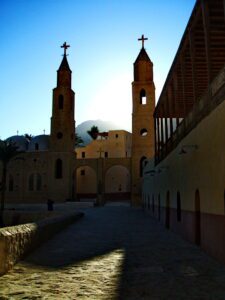The Red Sea Monasteries of Saint Anthony and Saint Paul
Hidden amid the arid Red Sea hills, far from the cities, are Egypt’s two oldest Coptic monasteries – St Paul’s and St Anthony’s. Their origins trace back to the early days of Christian monasticism, observing rituals that have scarcely changed over sixteen centuries.
The monasteries are among the holiest sites in the Coptic faith and the oldest in Monasticism traditions.You don’t have to be religious to appreciate their tranquil atmosphere and imposing setting, however, and there’s also scope for bird watching in the vicinity. Birdlife – hoopoes, desert larks, ravens, blue rock thrushes and pied wagtails – is surprisingly abundant, and you might glimpse some shy gazelles.
What to see:
The Monastery of St. Anthony was founded shortly after St. Anthony’s (the founder of monasticism in Egypt) death in the 4th century AD. The monastery was restored during the 12th century by Coptic monks.
Inside the monastery is effectively a self-contained village complete with lanes of two-storey dwellings, churches, mills and gardens of vines, olives and palms, surrounded by lofty walls with an interior catwalk, and a library of over 1600 manuscripts, all structures covered an area of 60,000 sq. m.(15 acres), with 25 resident monks.
You will face 1158 steps (a 45 minute walk) up to the cave 680m (2231 ft.) above the Red Sea, where St. Anthony lived at the age of 19. The stunning views from the top reward your effort: Technicolour valleys and massifs spill down into the azure gulf, with Sinai’s mountains rising beyond.
The Monastery of St. Paul has always been overshadowed by St Anthony’s. Dating to the 4th century, its titular founder St. Paul was only 16 and an orphan when he fled Alexandria to escape Emperor Decius’ persecutions, making him the earliest known hermit.
The monastery was a form of posthumous homage by Paul’s followers; its turreted walls are built around the cave where he lived for decades.
The monastery complex is much smaller than St Anthony’s and a little more primitive looking. It boasts 4 churches, but the Church of St Paul is its spiritual centre, a cave-church housing the remains of the saint.
There is also a two days hiking trip, which offers visitors the chance to experience the peace and tranquillity of the empty desert and its green oasis.
The popular image of the desert is of endless seas of sand. However, the vast expanse of rock in the interior of the desert is considered just as important and wondrous in its own right.
You’ll have a chance to feel the adrenaline rush while hiking in the desert and you’ll feel the childlike wonder when you spot indigenous wildlife in the area.
While camping out in the desert, you’ll experience one of the clearest night skies around as you sit in front of the camp fire and drink Bedouin tea then enjoy a traditional dinner.
Red Sea and South Sinai Mountains and Valleys, including hiking
The South Sinai Mountains are full of fabulous views, and what better way to experience them than through hiking? Though your legs may feel tired at times, you will be rewarded with stunning views and fresh mountain air, which will make you forget your tiredness in no time
The satisfaction of arriving at your destination, pushing the limits, and experiencing a new challenge on this great adventure will be an amazing story to tell when you return home.
St Catherine’s Monastery lies in the heart of South Sinai’s high mountain region, and the surrounding area is an ideal trekking destination.
If you are staying in Sharm el Sheikh or Dahab you still can hike in this area as it is only about 3 hours drive from those cities.
The rugged interior of the desert is populated by barren mountains, wind-sculpted canyons, and wadis that burst into life with even the briefest rains. The rocks and desert landscapes turn shades of pink, ochre(green), and black as the sun rises and falls, and what little vegetation there is appears to grow magically out of the rock.
The desert contains numerous peaks over 2000m (6562 ft.). Snow frequently covers the ground in winter and flash floods can occur all year round.
Bedouin often live in these mountainous areas, tending their sheep and goats. Their resourcefulness and freedom is incomparable and has allowed them to survive in South Sinai’s harsh and arid lands.
The wildlife here includes gazelles, foxes, ibexes, small rodents, and lizards. There are also a large number of birds, such as seagulls, falcons, herons, and other migratory species.
The flora consists mostly of large acacia trees and small shrubs. The variety of these shrubs are very interesting, with over 80 species, 34 of which are endemic, and only found in this region.
Enjoy the atmosphere of this quiet desert, far away from tourism, for a period of reflection, of contemplation, to find inner peace and harmony.
What to see:
St Catherine Monastery:
Mount Sinai, also known as Moses’ mountain, is revered by Christians, Muslims, and Jews alike, as it is believed that God delivered his Ten Commandments to Moses at its summit. There are three different routes up to the summit – the Camel Trail, which is the most common, the Steps of Repentance, and the longest but the most beautiful hike Al Arbaeen Valley.
Arbaeen Valley lies to the west of Moses’ Mountain and has impressive rock formations and beautiful scenery. A small Bedouin community lives in the valley and has become famous for raising an animal that was almost extinct in South Sinai, known as a Rock Hyrax. Halfway in the valley lays a rock which Moses is believed to have struck to create 12 springs in order to maintain the Children of Israel during the Exodus.
Egypt’s highest peak, St Catherine Mountain (2642m – 8667ft), lies 6 km south of Mount Sinai. According to traditions, it was on this peak that monks found the intact body of St Catherine, the peak can be reached on foot in 5 to 6 hours. On the summit are a chapel, a meteorological station, and 2 rooms for pilgrims to stay overnight. The summit offers a great panoramic view over the Sinai Peninsula.
Ain Khudra is a very small oasis located 12 km (7.5 miles) north of Nuweiba. Ain Khudra is a very beautiful oasis, with palm and guava trees, and hot water coming up from the ground. The lack of people here (only a few Bedouin and their goats) offers a tranquil part of Egypt, a total contrast to the big cities.
The longest valley in Sinai and the main route between the Gulf of Suez and Saint Catherine is the Feirn Valley. It has Sinai’s largest oasis with more than 12,000 date palms. Mount Serbal is the most important attraction and was believed by early Christians to have been the real Moses’ Mountain. Another important attraction is The Seven Sisters Nunnery.
One of the oldest man-made structures found in Sinai are the Nawamis, a series of stone tombs made from sandstone. The bones found inside these tombs date back to between 4000 and 3150 BC.
The Colored Canyon lies between St Catherine and Nuweiba. It derives its name from the layers of bright, multi-colored stones that resemble paintings on its steep narrow walls.
The White Canyon is smaller than the colored canyon. It runs between steep walls displaying incredible rock formations and ends at a sandy valley.
Abbas Basha Mountain is where the ruins of the palace built by the 19th-century king Abbas Hilmi I lie. Reaching the summit rewards you with stunning views.
Shag Valley offers luscious vegetation, springs and water holes.
Sarabit al Khadim can be reached from Abu Zenima or Wadi Feiran. It is famous for a ruined Pharaonic Temple surrounded by ancient turquoise mines and starkly beautiful landscape.
Mukattab Valley, known by the name Valley of Inscriptions, hosts Sinai’s largest collection of rock inscriptions and stela, some dating back to the 3rd dynasty.


